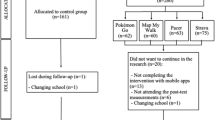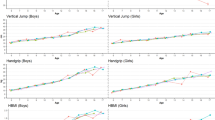Abstract
Background
Increased self-perceived fatigue (SpF) has already been identified in chronic conditions such as obesity, but it is also a growing problem in school-attending adolescents (±25%). This study tried to link body composition to SpF and physical activity/performance. Additionally, indicators for fatigue were determined.
Methods
A total of 452 adolescents were recruited. Body composition was measured and physical activity, physical performance, and SpF were assessed. Based on the total SpF (Multidimensional Fatigue Inventory) outcomes, three groups were created: low fatigue (LF) medium fatigue (MF) and high fatigue (HF).
Results
Fat was significantly lower in the LF group compared with MF (P<0,05) and HF (P<0.01). Grip endurance was increased in LF (P<0.05) and MF (P<0.01) compared with HF; similar results were found with the Cooper test. Sport Index was increased in LF compared with MF and HF (P<0.01). Fat and physical activity were related to fatigue (P<0.01). Decreased fatigue resistance, Sport Index and higher fat percentage increased the chance of being extremely fatigued.
Conclusion
This study emphasizes the importance of using fat mass and fat percentage instead of body mass index when screening adolescents. To prevent increased SpF, it is necessary to stimulate youngsters to be physically active and to promote healthy behaviors.
Similar content being viewed by others
Log in or create a free account to read this content
Gain free access to this article, as well as selected content from this journal and more on nature.com
or
References
deWater E, Braams BR, Crone EA, Peper JS . Pubertal maturation and sex steroids are related to alcohol use in adolescents. Horm Behav 2013;63:392–397.
Wang YF . Is obesity associated with early sexual maturation? A comparison of the association in American boys versus girls. Pediatrics 2002;110:903–910.
Marcovecchio ML, Chiarelli F . Obesity and growth during childhood and puberty. World Rev Nutr Diet 2013;106:135–141.
Cheng G, Buyken AE, Shi L et al. Beyond overweight: nutrition as an important lifestyle factor influencing timing of puberty. Nutr Rev 2012;70:133–152.
Pangrazi RP, Beighle A, Vehige T, Vack C . Impact of Promoting Lifestyle Activity for Youth (PLAY) on children's physical activity. J Sch Health 2003;73:317–321.
Strong WB, Malina RM, Blimkie CJ et al. Evidence based physical activity for school-age youth. J Pediatr 2005;146:732–737.
Tremblay MS, Leblanc AG, Janssen I et al. Canadian sedentary behaviour guidelines for children and youth. Appl Physiol Nutr Metab 2011;36:59–71.
Type 2 diabetes in children and adolescents. American Diabetes Association. Pediatrics 2000;105 (Pt 1): 671–680.
Hansen HS, Froberg K, Hyldebrandt N, Nielsen JR . A controlled study of eight months of physical training and reduction of blood pressure in children: the Odense schoolchild study. BMJ 1991;303:682–685.
Mitchell JA, Pate RR, Dowda M et al. A prospective study of sedentary behavior in a large cohort of youth. Med Sci Sports Exerc 2012;44:1081–1087.
Brownson RC, Boehmer TK, Luke DA . Declining rates of physical activity in the United States: what are the contributors? Annu Rev Public Health 2005;26:421–443.
Toriola OO, Monyeki MA, Toriola AL . Two-year longitudinal health-related fitness, anthropometry and body composition status amongst adolescents in Tlokwe Municipality: the PAHL study. Afr J Prim Health Care Fam Med 2015;7:896.
Duvigneaud N, Matton L, Wijndaele K et al. Relationship of obesity with physical activity, aerobic fitness and muscle strength in Flemish adults. J Sports Med Phys Fitness 2008;48:201–210.
HISIA Belgian Health Interview Survey - interactive analysis, 2011. https://www.wiv-isp.be/epidemio/hisia/index.htm.
Raitakari OT, Juonala M, Viikari JSA . Obesity in childhood and vascular changes in adulthood: insights into the cardiovascular risk in Young Finns Study. Int J Obesity 2005;29:S101–S104.
Berenson GS, Srinivasan SR, Bao WH et al. Association between multiple cardiovascular risk factors and atherosclerosis in children and young adults. N Engl J Med 1998;338:1650–1656.
Morrison KM, Shin S, Tarnopolsky M, Taylor VH . Association of depression & health related quality of life with body composition in children and youth with obesity. J Affect Disord 2014;172C:18–23.
Rank M, Wilks DC, Foley L et al. Health-related quality of life and physical activity in children and adolescents 2 years after an inpatient weight-loss program. J Pediatr 2014;165:732–7 e2.
Varni JW, Burwinkle TM, Katz ER, Meeske K, Dickinson P . The PedsQL in pediatric cancer: reliability and validity of the Pediatric Quality of Life Inventory Generic Core Scales, Multidimensional Fatigue Scale, and Cancer Module. Cancer 2002;94:2090–2106.
Varni JW, Burwinkle TM, Szer IS . The PedsQL Multidimensional Fatigue Scale in pediatric rheumatology: reliability and validity. J Rheumatol 2004;31:2494–2500.
Varni JW, Burwinkle TM,, Limbers CA, Szer IS . The PedsQL as a patient-reported outcome in children and adolescents with fibromyalgia: an analysis of OMERACT domains. Health Qual Life Outcomes 2007;5:9.
Palmer SN, Meeske KA, Katz ER, Burwinkle TM, Varni JW . The PedsQL Brain Tumor Module: initial reliability and validity. Pediatric Blood Cancer 2007;49:287–293.
Varni JW,, Limbers CA, Bryant WP, Wilson DP . The PedsQL multidimensional fatigue scale in pediatric obesity: feasibility, reliability and validity. Int J Pediatr Obes 2010;5:34–42.
Viner RM, Clark C, Taylor SJ et al. Longitudinal risk factors for persistent fatigue in adolescents. Arch Pediatr Adolesc Med 2008;162:469–475.
Mizuno K, Tanaka M, Fukuda S, Imai-Matsumura K, Watanabe Y . Relationship between cognitive functions and prevalence of fatigue in elementary and junior high school students. Brain Dev 2011;33:470–479.
Wan CS, Ward LC, Halim J et al. Bioelectrical impedance analysis to estimate body composition, and change in adiposity, in overweight and obese adolescents: comparison with dual-energy X-ray absorptiometry. BMC Pediatr 2014;14:249.
Baecke JA, Burema J, Frijters JE . A short questionnaire for the measurement of habitual physical activity in epidemiological studies. Am J Clin Nutr 1982;36:936–942.
Smets EMA, Garssen B, Bonke B, Dehaes JCJM . The Multidimensional Fatigue Inventory (MFI) psychometric qualities of an instrument to assess fatigue. J Psychosom Res 1995;39:315–325.
Bautmans I, Mets T . A fatigue resistance test for elderly persons based on grip strength: reliability and comparison with healthy young subjects. Aging Clin Exp Res 2005;17:217–222.
Bautmans I, Onyema O, Van Puyvelde K, Pleck S, Mets T . Grip work estimation during sustained maximal contraction: validity and relationship with dependency and inflammation in elderly persons. J Nutr Health Aging 2011;15:731–736.
Maher C, Crettenden A, Evans K et al. Fatigue is a major issue for children and adolescents with physical disabilities. Dev Med Child Neurol 2015;57:742–747.
Lim WJ, Hong S, Nelesen R, Dimsdale JE . The association fo obesity, cytokine levels, and depressive symptoms with diverse measures of fatigue in healthy subjects. Arch Intern Med 2005;165:910–915.
ter Wolbeek M, van Doornen LJ, Kavelaars A, Heijnen CJ . Severe fatigue in adolescents: a common phenomenon? Pediatrics 2006;117:e1078–e1086.
Acknowledgements
This research was supported by APB Provinciaal Onderwijs Antwerpen, in particular the board of PIVA. We also thank the commitment of the department of Physical Educational of PIVA for data acquisition, logistics, and technical support.
Author information
Authors and Affiliations
Corresponding author
Ethics declarations
Competing interests
The authors declare no conflict of interest.
Additional information
Ethical approval
All procedures performed in studies involving human participants were in accordance with the ethical standards of the institutional and/or national research committee and with the 1964 Helsinki declaration and its later amendments or comparable ethical standards. For this type of study, formal consent is not required.
Rights and permissions
About this article
Cite this article
Vantieghem, S., Bautmans, I., Tresignie, J. et al. Self-perceived fatigue in adolescents in relation to body composition and physical outcomes. Pediatr Res 83, 420–424 (2018). https://doi.org/10.1038/pr.2017.274
Received:
Accepted:
Published:
Issue date:
DOI: https://doi.org/10.1038/pr.2017.274
This article is cited by
-
Exploring the nexus between fatigue, body composition, and muscle strength in hemodialysis patients
European Journal of Medical Research (2024)
-
A cross-sectional study on the mental health of patients with COVID-19 1 year after discharge in Huanggang, China
European Archives of Psychiatry and Clinical Neuroscience (2023)
-
Pediatric quality of life multidimensional fatigue scale (PedsQL-MFS) detects the effects of a 3-week Inpatient body weight reduction program for children and adolescents with obesity
Health and Quality of Life Outcomes (2022)
-
Improved cognitive functioning in obese adolescents after a 30-week inpatient weight loss program
Pediatric Research (2018)



